Study Progress of Important Agricultural Heritage Systems (IAHS): A Literature Analysis
Abstract
:1. Introduction
2. Data and Methods
2.1. Data Sources
2.2. Analysis Method
3. Results
3.1. Analysis on the Research Progress of IAHS
3.1.1. Changes in the Number of Publications
3.1.2. Analysis of Issuing Countries and Institutions
3.1.3. Analysis of Author Group Characteristics
3.1.4. Cited Authors and Journals
3.2. Cluster Analysis of Research Hot Words
3.3. Analysis of the Emergence of Keywords in the Study of International IAHS
3.4. Co-Occurrence Cluster Analysis of Subject Terms
4. Conclusions and Prospects
4.1. Conclusions
4.1.1. Known Results
- (i)
- In terms of the publication time and quantity changes, international IAHS research from 2006 to 2020 can be summarized into two stages: fluctuating increase stage (2006–2014); and steady growth stage (2014–2020). The overall trend was increasing, but the number of publications was still relatively weak compared to other disciplines.
- (ii)
- At the research institution level, many networks of institutions studying GIAHS have been formed. They included the Chinese Academy of Sciences, the university of Florence, the university of Padua, CSIRO, China Agricultural University, the University of Arizona, etc. Among issuing countries, the order of the number of papers was China, Italy, the USA, Australia, England, and Germany. The number of papers issued by China was relatively high, but the centrality was low, indicating that China needs to strengthen international cooperation in research and enhance the international influence of research on GIAHS.
- (iii)
- At the author level, IAHS research mainly had many author groups. Among them, author groups of China, Italy, Japan, the USA, etc., played an important role in the development of international GIAHS. However, there is still no core author group in the world. In sum, the breadth of international cooperation in the research field has much room for improvement.
- (iv)
- In terms of highly cited authors and cited journals in the core collection of Web of Science, since 2006, anonymous papers were most cited at 40 times. The papers authored by Altieri and FAO accounted 28 citations. Agriculture Ecosystems & Environment was the most cited journal, which was cited 81 times. Its impact factor was 5.086 between 2018 and 2020. In terms of research keywords, the keywords of international IAHS research mainly focused on agricultural heritage systems, regeneration, agriculture, agroforestry, dry-stone wall, social capital, instability, agricultural biodiversity, etc. In terms of research topics, the 2006–2020 international IAHS research mainly focused on globally important agricultural heritage systems, tourism, livelihood assets, direct georeferencing, etc. On the whole, there were many and more concentrated papers on the research of IAHS based on geography, tourism, capital endowment, and biodiversity.
4.1.2. Unexpected Results
- (i)
- The study found that the geographical distribution of GIAHS study authors was mainly in Asia, such as China, Japan, India, etc.; and in Europe, such as Italy, Britain, Germany, France, Sweden, Spain, Denmark, Belgium, etc. Africa was mainly concentrated in the regions of South Africa and Ethiopia. The Oceania region included Australia; the America region included North America, including the United States, and South America, including Chile, Brazil, etc.
- (ii)
- More representative authors were distributed in China, Japan, Italy, Germany, France, the United States, and Australia. Scholars from various regions had their own focuses of writing papers. Scholars in the United States were more inclined to study the agricultural heritage systems in other countries or regions, such as agricultural cultural heritages in Africa [63,64] and Europe [65], especially in Africa, but to do few in their own countries. They also liked to study and compared agricultural heritage of cosmopolitan or local urban farms. Research contents included biodiversity and traditional agricultural systems [66], agricultural policies [65], food security [63], geographic exploration [64], etc. This is because the United States is an early industrial heritage country with relatively little agricultural heritage. In addition, Australian authors had also their own features in IAHS research. They were more inclined to study water pollution, recycling, and environmental pollution near the World Heritage site, the Great Barrier Reef [67,68]. Perhaps due to the long coastline of Australia, the Great Barrier Reef as the largest ecosystem in Australia is rich in biodiversity, so its water quality issues naturally attracted attention. In the Asian region, Japan and China had a rich agricultural heritage and their GIAHS projects started earlier, so authors studied heritage in a more comprehensive range. Early research in Japan mainly focused on agricultural products and tourisms, ecosystems, environmental management, etc. [53,69,70], and later studies focused on landscapes, etc., including the “Satoyama” system, which was a regional unit that developed agriculture, forestry, and fishery activities on the lands with Satoyama as the center [71]. Research contents of China included rice–fish systems and so on [22]. Representative countries in Europe included Italy, Germany, Spain, and France. Italian scholars often concentrated on writing in a certain area, and the research content was relatively extensive, mainly including ecosystem services, biodiversity, sustainable development, policy management measures, etc. [41,57,72]; German scholars tended to use vineyards as case sites in related research [73], and the content was mainly about biodiversity, landscape, etc. [29,74]. This phenomenon may be related to the abundance of wine in Germany. In addition, due to the better natural scenery in Spain, Spanish scholars tended to study landscape use [30]; French scholars tended to study the terms of biodiversity [75]. Authors in Africa did not form a large cluster, and the research content mainly focused on traditional knowledge [76].
- (iii)
- In addition, various countries had connections in spatial research. As mentioned earlier, the United States and Africa were linked in GIAHS research. British scholars usually also studied the agricultural heritage of other countries such as Egypt and Turkey because of the early industrial development in England, and therefore established relevant social networks with these countries [77,78]. In terms of research content, both Chinese scholars and Australian scholars conducted research on the sustainable development of rice [22,79]. In grassland management, France and Australia also established a content network structure [47,80]. Similar to German research, Italy also conducted related research on vineyard-related biodiversity and economic development [81]. In some regions, real across-country cooperation has been conducted. In October 2013, China, Japan, and South Korea agreed to the Chinese proposal to establish the East Asia Research Association for Agricultural Heritage Systems (ERAHS). The ERAHS conference has been organized every year since 2014, except for 2020, with three countries rotating as the host country [4]. Therefore, based on the differences and connections between different regions in terms of space, GIAHS should strengthen spatial connections in the future.
- (iv)
- Different GIAHS forms in different countries and regions result in their different management and development approaches of GIAHS. Asia, Japan, South Korea, and China had very similar natural conditions, but GIAHS types in Japan were relatively rich, and various reasonable multi-stakeholder participation mechanisms have been built in different GIAHS sites. Therefore, it had advantages in urban agriculture and historical and cultural inheritance. For example, cooperative networks of GIAHS organized spontaneously by governments in GIAHS sites played an important role in promoting the development and protection of GIAHS in Southeast Asia [11]. In Europe, vineyards and botanical gardens were main types of GIAHS. Spain and Italy were the regions where GIAHS were distributed. Management measures of governments were top-down, government-oriented, and had relatively specific ways. In America, the research on GIAHS mainly focused on suburban agricultural protection and urban farms because of the earlier industrial development. Moreover, Italy and China both have many types of heritages related to agriculture, so they could help each other in cross-regional sustainability. Other countries or regions that had similarly weak policy support could learn from GIAHS in Japan.
4.1.3. Significance
4.2. Potential Limitations
- (i)
- This research method adopts bibliometrics and all results are based on CiteSpace algorithms. Using this method helps to clearly analyze trends of IAHS research fields in a visual form and predict future research frontiers. However, it can only reflect the number of papers published in the research fields and the main situations of the cooperation networks. For some cooperation, the results cannot fully reflect them. In addition, the results of this study can be verified by other visualization software like VOSviewer, Citenet, or Python. Due to different algorithms of different software, the results are probably different to some extent, but they are generally consistent. In the future, multiple software programs can be used to analyze the IAHS literature for verifying results and discussing their differences.
- (ii)
- This study only used the core collection of the WOS database as the data source, so articles not included in the core collection of the WOS database were not analyzed. Therefore, this research may omit some studies on IAHS. However, considering the WOS core collection has a higher international influence and the number of user groups is huge, the selected WOS data can reflect the overall global research trend and current status of GIAHS. Another limitation is that IAHS in this paper is not a commonly used term in some countries. It may leave out existing studies in different regions of the world. However, using IAHS as a search term can accommodate some regions where researchers use IAHS as a research vocabulary, because in these areas, such as China, South Korea, and Japan, IAHS research includes not only GIAHS-related research but also NIAHS-related research. Therefore, using IAHS or GIAHS as a combination search term, compared to using GIAHS as a search term alone, is more complete and has more practical significance for the summary of past research and trend prediction analyses of future research in related fields. Moreover, GIAHS covers lots of elements, and the related research is very extensive. Just taking GIAHS as a search term, those professional literatures excluding the word “GIAHS” would be missed even if they consciously studied issues about GIAHS. In terms of time setting, this study set the time range as the 15 years from 2006 to 2020, and the key articles before 2006 and after 2020 were not included. However, results can still reflect the development trend of international GIAHS because of the missed literature constituting just a small proportion. In the future, a broader research scope can be found in this study.
- (iii)
- In terms of result analyses, authors, countries, institutions, keywords, subject words, etc., were selected for analysis, and only general trends of these indicators were analyzed. More detailed analyses need further verification. In addition, this research is mainly based on the research methods of Chen, C.M., and it has some inevitable limitations in analytical methods. However, this research aims to present the general international trends of agricultural cultural heritages. The selected indicators can meet the research object. Moreover, some key documents were cited in the text to support these analytical results, which have summarized information from many key research themes. At the same time, they also supplemented connections and different features existing in the GIAHS space.
4.3. Research Prospects
- (i)
- The research contents of international IAHS expand to the fields of applications and microscopic views
- (ii)
- International IAHS should strengthen research in the field of social sciences so that we can build a comprehensive disciplinary system
- (iii)
- The international IAHS should strengthen the application of standardized quantitative research methods to improve the scientific nature of research processes and results
- (iv)
- Broaden international cooperation of research groups on IAHS research
Author Contributions
Funding
Institutional Review Board Statement
Data Availability Statement
Acknowledgments
Conflicts of Interest
References
- Koohafkan, P.; Altieri, M.A. Globally Important Agricultural Heritage Systems: A Legacy for the Future; Food and Agriculture Organization of the United Nations: Rome, Italy, 2011. [Google Scholar]
- FAO. 2017. Available online: http://www.fao.org/giahs/background/en/ (accessed on 17 September 2017).
- FAO. Agricultural Heritage around the World, GIAHS around the World. 2020. Available online: http://www.fao.org/giahs (accessed on 20 December 2020).
- Kajihara, H.; Zhang, S.; You, W.H.; Min, Q.W. Concerns and Opportunities around Cultural Heritage in East Asian Globally Important Agricultural Heritage Systems (GIAHS). Sustainability 2018, 10, 1235. [Google Scholar] [CrossRef] [Green Version]
- Agnoletti, M.; Emanueli, F.; Corrieri, F.; Venturi, M.; Santoro, A. Monitoring Traditional Rural Landscapes. The Case of Italy. Sustainability 2019, 11, 6107. [Google Scholar] [CrossRef] [Green Version]
- Zhang, Y.; Li, X.; Min, Q. How to balance the relationship between conservation of Important Agricultural Heritage Systems (IAHS) and socio-economic development? A theoretical framework of sustainable industrial integration development. J. Clean. Prod. 2018, 204, 553–563. [Google Scholar] [CrossRef]
- Min, Q.W. Globally Important Agricultural Cultural Heritage—A New Type of World Heritage. Resour. Sci. 2006, 28, 206. [Google Scholar]
- Kohsaka, R.; Matsuoka, H.; Uchiyama, Y.; Rogel, M. Regional management and biodiversity conservation in GIAHS: Text analysis of municipal strategy and tourism management. Ecosyst. Health Sustain. 2019, 5, 124–132. [Google Scholar] [CrossRef]
- Kohsaka, R.; Matsuoka, H. Analysis of Japanese Municipalities with Geopark, MAB, and GIAHS Certification: Quantitative Approach to Official Records with Text-Mining Methods. SAGE Open 2015, 5, 1. [Google Scholar] [CrossRef] [Green Version]
- Uchiyama, Y.; Tanaka, Y.; Matsuoka, H. Expectations of residents and tourists of agriculture-related certification systems: Analysis of public perceptions. J. Ethn. Foods 2017, 4, 110–117. [Google Scholar] [CrossRef]
- Kajima, S.; Tanaka, Y.; Uchiyama, Y. Japanese Sake and Tea as place-based products: A comparison of regional certifications of GIAHS, Geopark, Biosphere Reserves, and GI at product level certification. J. Ethn. Foods 2017, 4, 80–87. [Google Scholar] [CrossRef]
- Nagata, A.; Yiu, E. Ten Years of GIAHS Development in Japan. J. Resour. Ecol. 2021, 12, 567–577. [Google Scholar]
- Zhang, Y.; He, L.; Min, Q. Research progress of domestic agricultural cultural heritage based on literature statistics. Resour. Sci. 2017, 39, 175–187. [Google Scholar]
- Lu, J.; Li, X. Review of rice–fish-farming systems in China—One of the Globally Important Ingenious Agricultural Heritage Systems (GIAHS). Aquaculture 2006, 260, 106–113. [Google Scholar] [CrossRef]
- Chen, Y.; Munteanu, A.; Huang, Y. Mapping Receptor Density on Live Cells by Using Fluorescence Correlation Spectroscopy. Chem. A Eur. J. 2009, 15, 5327–5336. [Google Scholar] [CrossRef] [PubMed]
- Faust, O.; Hagiwara, Y.; Hong, T. Deep learning for healthcare applications based on physiological signals: A review. Comput. Methods Programs Biomed. 2018, 161, 1–13. [Google Scholar] [CrossRef]
- Chen, C. CiteSpace II: Detecting and visualizing emerging trends and transient patterns in scientific literature. J. Am. Soc. Inf. Sci. Technol. 2006, 57, 359–377. [Google Scholar] [CrossRef] [Green Version]
- Cheng, F.; Huang, Y.; Yu, H. Mapping knowledge structure by keyword co-occurrence and social network analysis. Libr. Hi Tech. 2018, 36, 636–650. [Google Scholar] [CrossRef]
- Freeman, L.C. Centrality in social networks: Conceptual clarification. Soc. Netw. 1978, 1, 215–239. [Google Scholar] [CrossRef] [Green Version]
- Price, D.J.; Monaghan, J.J. An energy-conserving formalism for adaptive gravitational force softening in SPH and N-body codes. Mon. Not. R. Astron. Soc. 2006, 374, 1347–1358. [Google Scholar] [CrossRef] [Green Version]
- Chen, C.; Dubin, R.; Kim, M. Emerging trends and new developments in regenerative medicine: A scientometric update (2000–2014). Expert Opin. Biol. Ther. 2014, 14, 1295. [Google Scholar] [CrossRef] [Green Version]
- Xie, J.; Hu, L.; Tang, J. Ecological mechanisms underlying the sustainability of the agricultural heritage rice-fish coculture system. Proc. Natl. Acad. Sci. USA 2011, 108, 19851–19852. [Google Scholar] [CrossRef] [Green Version]
- Tucci, G.; Parisi, E.; Castelli, G. Multi-Sensor UAV Application for Thermal Analysis on a Dry-Stone Terraced Vineyard in Rural Tuscany Landscape. Int. J. Geo-Inf. 2019, 8, 87. [Google Scholar] [CrossRef] [Green Version]
- Santoro, A.; Venturi, M.; Ben Maachia, S.; Benyahia, F.; Corrieri, F.; Piras, F.; Agnoletti, M. Agroforestry Heritage Systems as Agrobiodiversity Hotspots. The Case of the Mountain Oases of Tunisia. Sustainability 2020, 12, 4054. [Google Scholar] [CrossRef]
- Santoro, A.; Aguilar, E.A.M.; Venturi, M.; Piras, F.; Corrieri, F.; Quintanilla, J.R.; Agnoletti, M. The Agroforestry Heritage System of Sabana De Morro in El Salvador. Forests 2020, 11, 747. [Google Scholar] [CrossRef]
- Chen, C. Emerging trends in regenerative medicine: A scientometric analysis in CiteSpace. Expert Opin. Biol. Ther. 2012, 12, 593–608. [Google Scholar] [CrossRef]
- Ren, W.; Hu, L.; Guo, L. PNAS Plus: Preservation of the genetic diversity of a local common carp in the agricultural heritage rice–fish system. Proc. Natl. Acad. Sci. USA 2018, 115, E546–E554. [Google Scholar] [CrossRef] [Green Version]
- Cucchiaro, S.; Fallu, D.J.; Zhang, H. Multiplatform-SFM and TLS Data Fusion for Monitoring Agricultural Terraces in Complex Topographic and Landcover Conditions. Remote Sens. 2020, 12, 1946. [Google Scholar] [CrossRef]
- Regina, L.; Jan, B.; Åke, B. A landscape perspective on conservation of semi-natural grasslands. Agric. Ecosyst. Environ. 2008, 125, 213–222. [Google Scholar]
- Calvo-Iglesias, M.S.; Crecente-Maseda, R.; Fra-Paleo, U. A case study from NW Spain. J. Archit. Eng. 2006, 78, 334–343. [Google Scholar]
- Munroe, D. Changing Rural Landscapes in Albania: Cropland Abandonment and Forest Clearing in the Postsocialist Transition. Ann. Assoc. Am. Geogr. 2008, 98, 855–876. [Google Scholar]
- Sun, Y.; Cheng, S. Tourism Potential of Agricultural Heritage Systems. Tour. Geogr. 2011, 13, 112–128. [Google Scholar] [CrossRef]
- Indrawan, M.; Yabe, M.; Nomura, H.; Harrison, R. Deconstructing satoyama—The socio-ecological landscape in Japan. Ecol. Eng. 2014, 64, 77–84. [Google Scholar] [CrossRef]
- Qiu, Z.; Chen, B.; Takemoto, K. Conservation of terraced paddy fields engaged with multiple stakeholders: The case of the Noto GIAHS site in Japan. Paddy Water Environ. 2014, 12, 275–283. [Google Scholar] [CrossRef]
- Swinton, S.M.; Lupi, F.; Robertson, G.; Hamilton, S.K. Ecosystem services and agriculture: Cultivating agricultural ecosystems for diverse benefits. Ecol. Econ. 2007, 64, 245–252. [Google Scholar] [CrossRef]
- Soriano, M.A.; Herath, S. Quantifying the role of traditional rice terraces in regulating water resources: Implications for management and conservation efforts. Agroecol. Sustain. Food Syst. 2018, 42, 885–910. [Google Scholar] [CrossRef]
- Kamiyama, C.; Hashimoto, S.; Kohsaka, R.; Saito, O. Non-market food provisioning services via homegardens and communal sharing in Satoyama socio-ecological production landscapes on Japan’s Noto Peninsula. Ecosyst. Serv. 2016, 17, 185–196. [Google Scholar] [CrossRef]
- Rudnev, V. The factor of local cultural specificity and process of globalization. Coll. Antropol. 2012, 36, 1135–1138. [Google Scholar] [PubMed]
- Brodie, J.; Pearson, R.G. Ecosystem health of the Great Barrier Reef: Time for effective management action based on evidence. Estuar. Coast. Shelf Sci. 2016, 183, 438–451. [Google Scholar] [CrossRef]
- Santoro, A.; Venturi, M.; Agnoletti, M. Agricultural Heritage Systems and Landscape Perception among Tourists. The Case of Lamole, Chianti (Italy). Sustainability 2020, 12, 3509. [Google Scholar] [CrossRef]
- Adams, J.B.; Taljaard, S.; Van Niekerk, L.; Lemley, D.A. Nutrient enrichment as a threat to the ecological resilience and health of South African microtidal estuaries. Afr. J. Aquat. Sci. 2020, 45, 23–40. [Google Scholar] [CrossRef] [Green Version]
- Cullotta, S.; Barbera, G. Mapping traditional cultural landscapes in the Mediterranean area using a combined multidisciplinary approach: Method and application to Mount Etna (Sicily; Italy). Landsc. Urban Plan. 2011, 100, 98–108. [Google Scholar] [CrossRef]
- Santoro, A.; Venturi, M.; Bertani, R.; Agnoletti, M.A. Review of the Role of Forests and Agroforestry Systems in the FAO Globally Important Agricultural Heritage Systems (GIAHS) Programme. Forests 2020, 11, 860. [Google Scholar] [CrossRef]
- Reyes, S.R.C.; Miyazaki, A.; Yiu, E.; Saito, O. Enhancing Sustainability in Traditional Agriculture: Indicators for Monitoring the Conservation of Globally Important Agricultural Heritage Systems (GIAHS) in Japan. Sustainability 2020, 12, 5656. [Google Scholar] [CrossRef]
- Tian, M.; Min, Q.; Jiao, W.; Yuan, Z. Agricultural heritage systems tourism: Definition, characteristics and development framework. J. Mt. Sci. 2016, 3, 72–86. [Google Scholar] [CrossRef]
- Barrena, J.; Nahuelhual, L.; Baez, A.; Schiappacasse, I.; Cerda, C. Valuing cultural ecosystem services: Agricultural heritage in Chiloe island, southern Chile. Ecosyst. Serv. 2014, 7, 66–75. [Google Scholar] [CrossRef]
- Kemp, D.R.; Michalk, D.L. Towards sustainable grassland and livestock management. J. Agric. Sci. 2007, 145, 543–564. [Google Scholar] [CrossRef] [Green Version]
- Diniz, F.H.; Hoogstra-Klein, M.A.; Kok, K.; Arts, B. Livelihood strategies in settlement projects in the brazilian amazon: Determining drivers and factors within the agrarian reform program. J. Rural Stud. 2013, 32, 196–207. [Google Scholar] [CrossRef]
- Tian, M.; Min, Q.; Lun, F.; Yuan, Z.; Fuller, A.; Yang, L.; Zhou, J. Evaluation of tourism water capacity in agricultural heritage sites. Sustainability 2015, 7, 15548–15569. [Google Scholar] [CrossRef] [Green Version]
- Li, J.; Min, Q.W.; Li, W.H.; Bai, Y.Y.; Yang, L.; Bijaya, G.C.D. Evaluation of water resources conserved by forests in the Hani rice terraces system of Honghe County, Yunnan, China: An application of the fuzzy comprehensive evaluation model. J. Mt. Sci. 2016, 13, 744–753. [Google Scholar] [CrossRef]
- Sugimoto, R.; Kasai, A.; Tait, D.R.; Rihei, T.; Hirai, T.; Asai, K.; Tamura, Y.; Yamashita, Y. Traditional land use effects on nutrient export from watersheds to coastal seas. Nutr. Cycl. Agroecosyst. 2020, 119, 7–21. [Google Scholar] [CrossRef]
- Yuji, H.; Yuki, S.; Hirotaka, T. The Minabe-Tanabe Ume System: Linkage of Landscape Units by Locals. Sustainability 2018, 10, 1079. [Google Scholar]
- Thorburn, P.J.; Wilkinson, S.N.; Silburn, D.M. Water quality in agricultural lands draining to the Great Barrier Reef: Causes, management and priorities. Agric. Ecosyst. Environ. 2013, 180, 4–20. [Google Scholar] [CrossRef]
- Bernues, A.; Clemetsen, M.; Eik, L.O. Seeing Northern European Fjord and Mountain Agriculture through Farmers’ Eyes. Mt. Res. Dev. 2016, 36, 276–285. [Google Scholar] [CrossRef]
- Dedeurwaerdere, T.; Hannachi, M. Socio-economic drivers of coexistence of landraces and modern crop varieties in agrobiodiversity rich Yunnan rice fields. Ecol. Econ. 2019, 159, 177–188. [Google Scholar] [CrossRef]
- Morar, M.; Agachi, P.S. Review: Important contributions in development and improvement of the heat integration techniques. Comput. Chem. Eng. 2010, 34, 1171–1179. [Google Scholar] [CrossRef]
- Battaglini, L.; Bovolenta, S.; Gusmeroli, F.; Salvador, S.; Sturaro, E. Environmental sustainability of Alpine livestock farms. Ital. J. Anim. Sci. 2014, 13, 3155. [Google Scholar] [CrossRef]
- Sibelet, N.; Chamayou, L.; Newing, H.; Montes, I.G. Perceptions of Trees Outside Forests in Cattle Pastures: Land Sharing Within the Central Volcanic Talamanca Biological Corridor, Costa Rica. Hum. Ecol. 2017, 45, 499–511. [Google Scholar] [CrossRef]
- Zhang, Y.; Min, Q.; Li, H.; He, L.; Zhang, C.; Yang, L. A conservation approach of globally important agricultural heritage systems (GIAHS): Improving traditional agricultural patterns and promoting scale-production. Sustainability 2017, 9, 295. [Google Scholar] [CrossRef] [Green Version]
- Garcia, M.A.; Yague, J.L.; de Nicolas, V.L.; Diaz-Puente, J.M. Characterization of Globally Important Agricultural Heritage Systems (GIAHS) in Europe. Sustainability 2020, 12, 1611. [Google Scholar] [CrossRef] [Green Version]
- Zhang, Y.; Min, Q.; Jiao, W.; Liu, M. Values and Conservation of Honghe Hani Rice Terraces System as a GIAHS Site. J. Resour. Ecol. 2016, 7, 197–204. [Google Scholar]
- Su, M.M.; Dong, Y.Z.; Wall, G.; Sun, Y.H. A value-based analysis of the tourism use of agricultural heritage systems: Duotian Agrosystem, Jiangsu Province, China. J. Sustain. Tour. 2020, 28, 2136–2155. [Google Scholar] [CrossRef]
- Kerr, R.B. Food Security in Northern Malawi: Gender, Kinship Relations and Entitlements in Historical Context. J. S. Afr. Stud. 2005, 31, 53–74. [Google Scholar] [CrossRef]
- Wondie, M.; Schneider, W.; Melesse, A.M.; Teketay, D. Spatial and Temporal Land Cover Changes in the Simen Mountains National Park, a World Heritage Site in Northwestern Ethiopia. Remote Sens. 2011, 3, 752–766. [Google Scholar] [CrossRef] [Green Version]
- Bowen, S.; Master, K.D. New rural livelihoods or museums of production? Quality food initiatives in practice. J. Rural Stud. 2011, 27, 73–82. [Google Scholar] [CrossRef]
- Altieri, M.A. Linking ecologists and traditional farmers in the search for sustainable agriculture. Front. Ecol. Environ. 2004, 2, 35–42. [Google Scholar] [CrossRef]
- Kroon, F.J.; Thorburn, P.; Schaffelke, B.; Whitten, S. Towards protecting the Great Barrier Reef from land-based pollution. Glob. Chang. Biol. 2016, 22, 1985–2002. [Google Scholar] [CrossRef] [Green Version]
- Narayan, K.A.; Schleeberger, C.; Bristow, K.L. Modelling seawater intrusion in the Burdekin Delta Irrigation Area, NorthQueensland, Australia. Agric. Water Manag. 2007, 89, 217–228. [Google Scholar] [CrossRef]
- Ohe, Y.; Kurihara, S. Evaluating the complementary relationship between local brand farm products and rural tourism: Evidence from Japan. Tour. Manag. 2013, 35, 278–283. [Google Scholar] [CrossRef]
- Hashimoto, S.; Nakamura, S.; Saito, O.; Kohsaka, R.; Kamiyama, C.; Tomiyoshi, M.; Kishioka, T. Mapping and characterizing ecosystem services of social–ecological production landscapes: Case study of Noto, Japan. Sustain. Sci. 2015, 10, 257–273. [Google Scholar] [CrossRef]
- Miyake, Y.; Uchiyama, Y.; Fujihira, Y.; Kohsaka, R. Towards Evidence Based Policy Making in GIAHS: Convention Theory and Effects of GIAHS Registration on the Wholesale and Retail Trade of Traditional and Local Vegetables. Sustainability 2021, 13, 5330. [Google Scholar] [CrossRef]
- Vinceti, B.; Termote, C.; Ickowitz, A.; Powell, B.; Kehlenbeck, K.; Hunter, D. The Contribution of Forests and Trees to Sustainable Diets. Sustainability 2013, 5, 4797–4824. [Google Scholar] [CrossRef] [Green Version]
- Winkler, K.J.; Viers, J.H.; Nicholas, K.A. Assessing Ecosystem Services and Multifunctionality for Vineyard Systems. Front. Environ. Sci. 2017, 5, 3155. [Google Scholar] [CrossRef] [Green Version]
- Hennenberg, K.J.; Dragisic, C.; Haye, S.; Hewson, J.; Semroc, B.; Savy, C.; Wiegmann, K.; Fehrenbach, H.; Fritsche, U.R. The Power of Bioenergy-Related Standards to Protect Biodiversity. Conserv. Biol. 2010, 24, 412–423. [Google Scholar] [CrossRef]
- Pautasso, M.; Aistara, G.; Barnaud, A.; Caillon, S.; Clouvel, P. Seed exchange networks for agrobiodiversity conservation. A review. Agron. Sustain. Dev. 2013, 33, 151–175. [Google Scholar] [CrossRef] [Green Version]
- Kandari, L.S.; Phondani, P.C.; Payal, K.C.; Rao, K.S.; Maikhuri, R.K. Ethnobotanical study towards conservation of medicinal and aromatic plants in upper catchments of Dhauli Ganga in the central Himalaya. J. Mt. Sci. 2012, 9, 286–296. [Google Scholar] [CrossRef]
- Bush, R. Politics, power and poverty: Twenty years of agricultural reform and market liberalisation in Egypt. Third World Q. 2007, 28, 1599–1615. [Google Scholar] [CrossRef]
- Yilmaz, O.; Ertugrul, M.; Wilson, R.T. Domestic livestock resources of Turkey. Trop. Anim. Health Prod. 2012, 44, 707–714. [Google Scholar] [CrossRef]
- Gaydon, D.S.; Probert, M.E.; Buresh, R.J.; Meinke, H.; Suriadi, A.; Dobermann, A.; Bouman, B.; Timsina, J. Rice in cropping systems—Modelling transitions between flooded and non-flooded soil environments. Eur. J. Agron. 2012, 39, 9–24. [Google Scholar] [CrossRef]
- Gibon, A. Managing grassland for production, the environment and the landscape. Challenges at the farm and the landscape level. Livest. Prod. Sci. 2005, 96, 11–31. [Google Scholar] [CrossRef]
- Tudisca, S.; Sgroi, F.; Testa, R. Competitiveness and sustainability of extreme viticulture in Pantelleria Island. New Medit 2011, 10, 57–64. [Google Scholar]
- Wang, S.; Min, Q. Agricultural Heritage Systems and Agriculture, Peasants, Countryside; China Environment Sciences Press: Beijing, China, 2009. [Google Scholar]

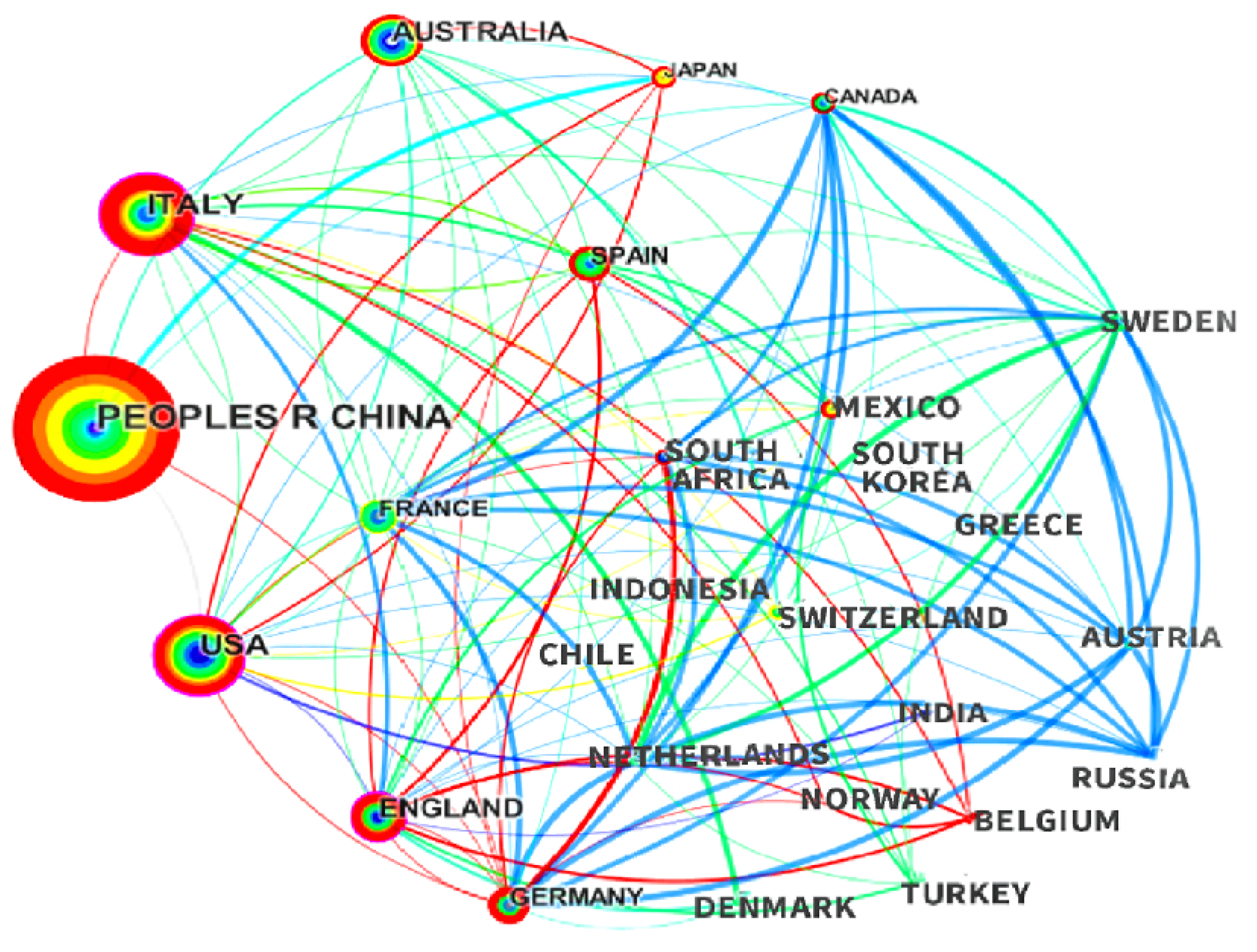
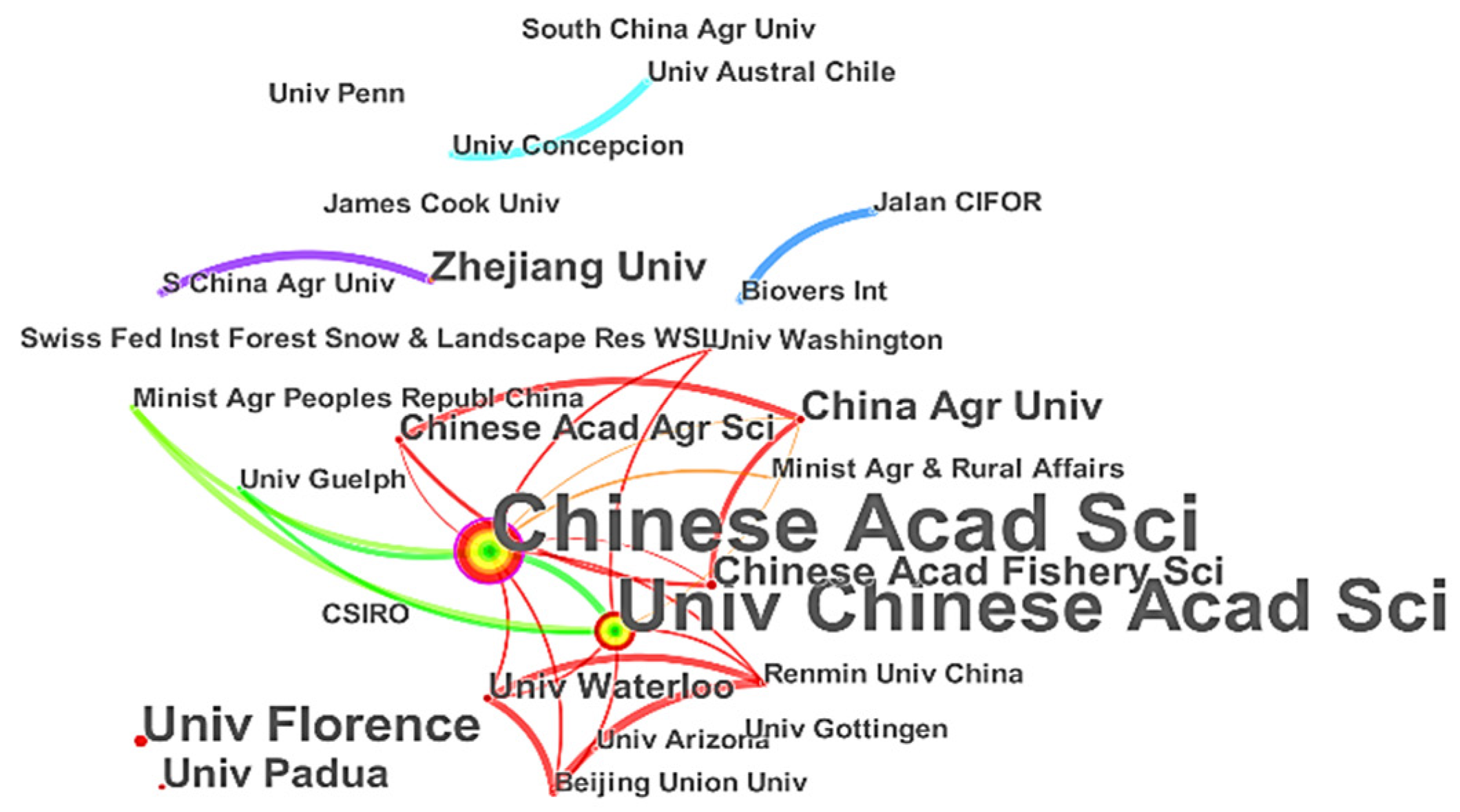
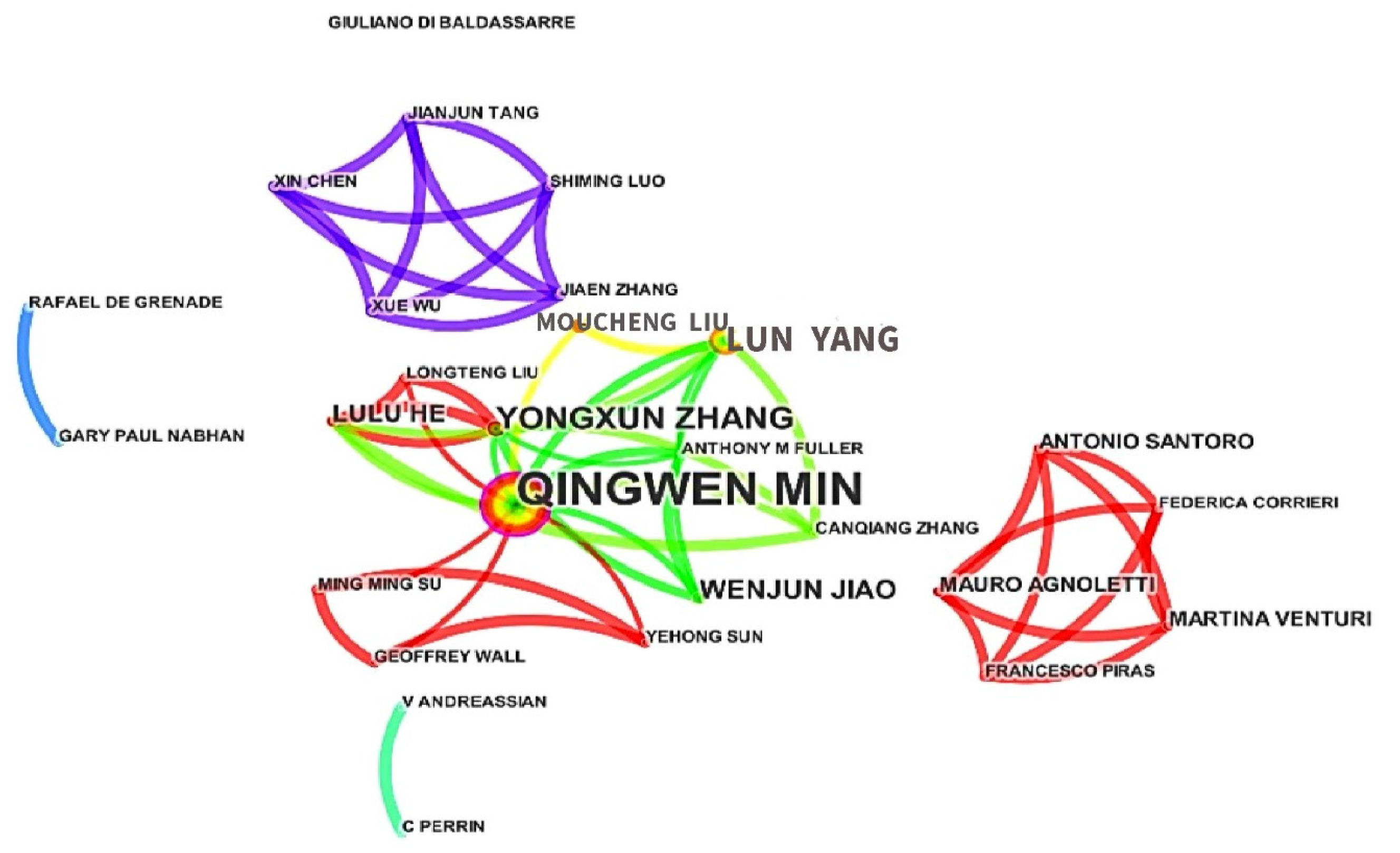
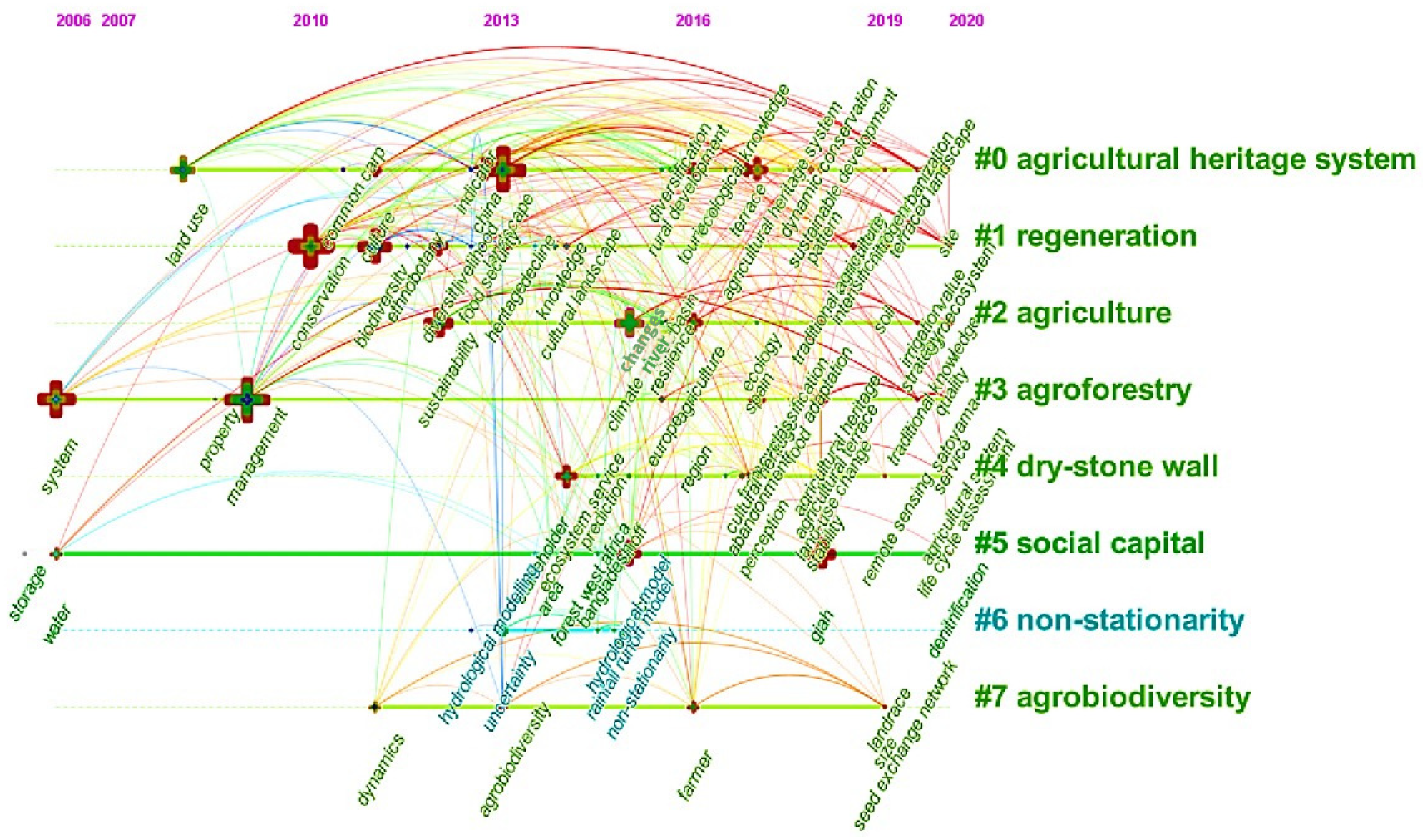
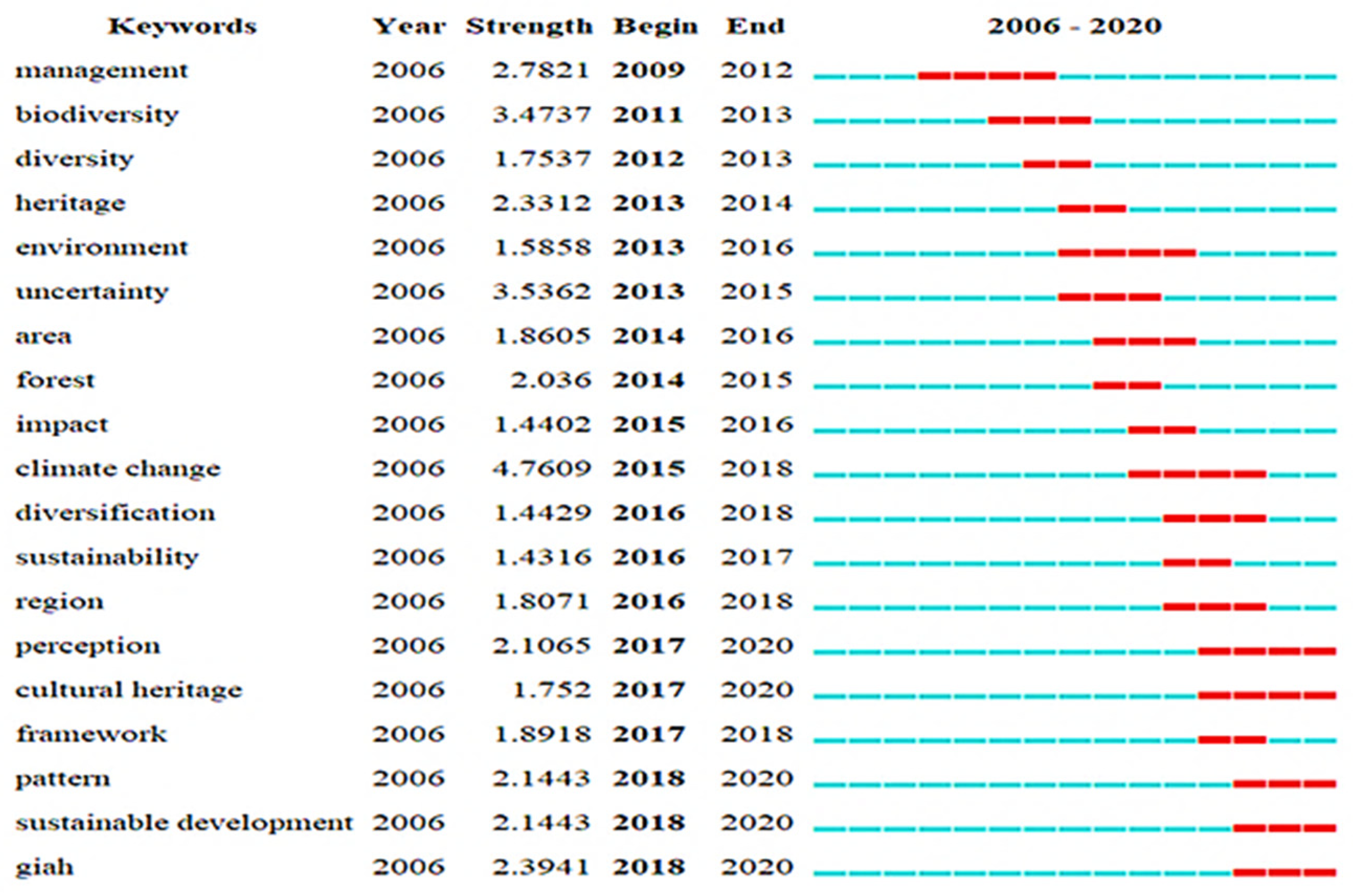
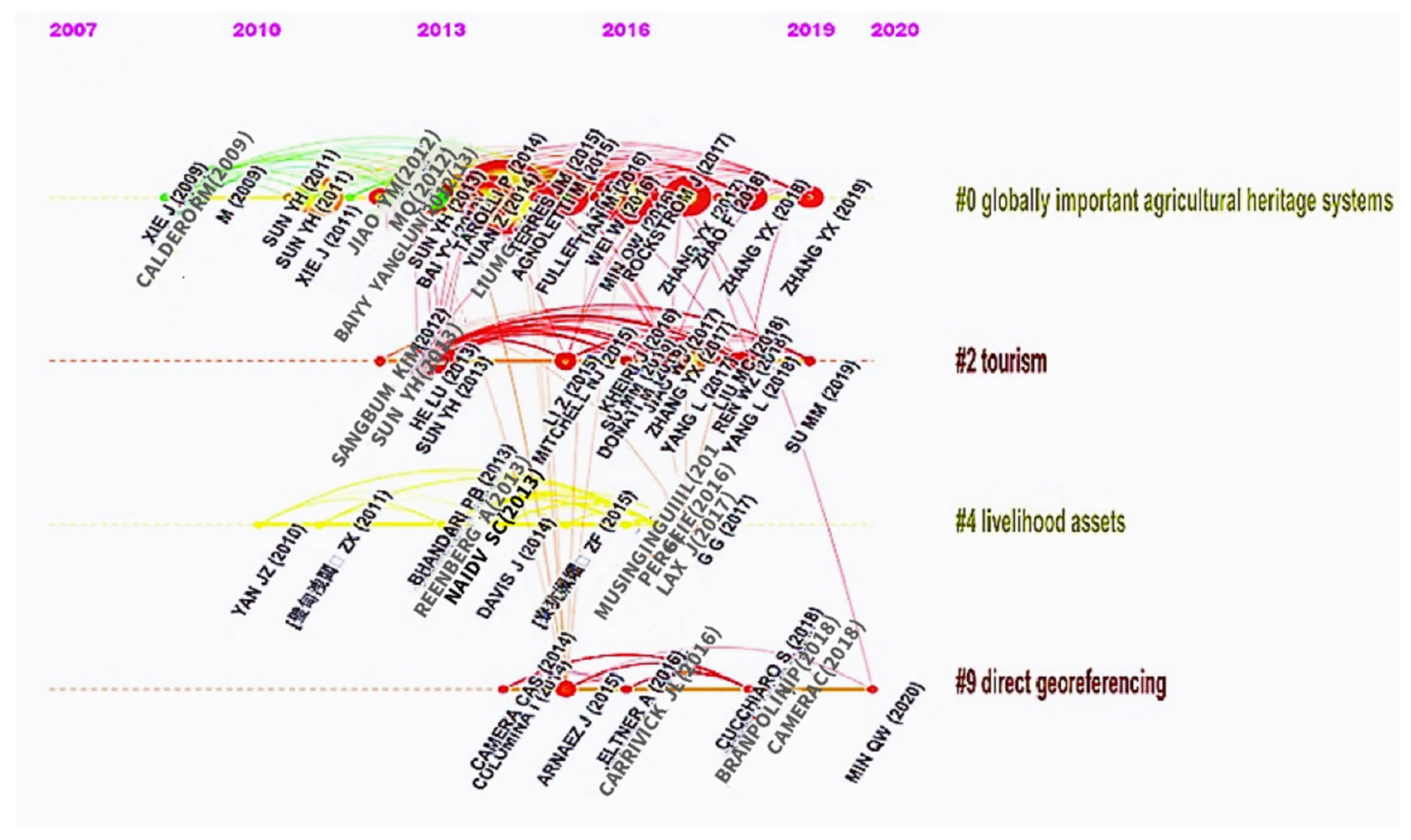
| The Serial Number | Count | Centrality | Country | Proportion |
|---|---|---|---|---|
| 1 | 70 | 0.00 | China | 23.97% |
| 2 | 38 | 0.15 | Italy | 13.01% |
| 3 | 37 | 0.11 | The USA | 12.67% |
| 4 | 25 | 0.07 | Australia | 8.56% |
| 5 | 22 | 0.19 | England | 7.53% |
| 6 | 17 | 0.10 | Germany | 5.82% |
| 7 | 17 | 0.01 | Spain | 5.82% |
| 8 | 16 | 0.04 | Japan | 5.48% |
| 9 | 16 | 0.04 | France | 3.42% |
| 10 | 10 | 0.02 | Canada | 3.42% |
| Serial Number | Centrality | Institution | Affiliation |
|---|---|---|---|
| 1 | 0.49 | Chinese Acad Sci | China |
| 2 | 0.02 | Univ Chinese Acad Sci | China |
| 3 | 0.00 | Univ Florence | Italy |
| 4 | 0.00 | Univ Padua | Italy |
| 5 | 0.01 | CSIRO | Australia |
| 6 | 0.00 | China Agr Univ | China |
| 7 | 0.00 | Chinese Acad Fishery Sci | China |
| 8 | 0.00 | Univ Arizona | USA |
| 9 | 0.00 | Zhejiang Univ | China |
| Serial Number | Count | Centrality | Authors | Proportion |
|---|---|---|---|---|
| 1 | 24 | 0.10 | Min, Q. | 8.22% |
| 2 | 12 | 0.01 | Yang, L. | 4.11% |
| 3 | 7 | 0.01 | Zhang, Y. | 2.40% |
| 4 | 6 | 0.00 | Liu, M. | 2.05% |
| 5 | 5 | 0.00 | Jiao, W. | 1.71% |
| 6 | 4 | 0.00 | Venturi, M. | 1.37% |
| 7 | 4 | 0.00 | Agnoletti, M. | 1.37% |
| 8 | 4 | 0.00 | Santoro, A. | 1.37% |
| 9 | 4 | 0.00 | He, L. | 1.37% |
| Cited Times | Centrality | Cited Author Name |
|---|---|---|
| 40 | 0.03 | Anonymous |
| 28 | 0.04 | Altieri, M.A. |
| 28 | 0.01 | FAO |
| 25 | 0.01 | Sun, Y.H. |
| 21 | 0.03 | Liu, M.C. |
| 19 | 0.01 | Min, Q.W. |
| 16 | 0.13 | Koohafkan, P. |
| 16 | 0.12 | Zhang, Y. |
| Cited Times | Centrality | The Impact of Factors (Three Years) | Cited Journal Name |
|---|---|---|---|
| 81 | 0.15 | 2018: 3.954; 2019: 4.241; 2020: 5.567 | Agriculture Ecosystems & Environment |
| 72 | 0.04 | 2018: 3.573; 2019: 3.682; 2020: 5.398 | Land Use Policy |
| 64 | 0.16 | 2018: 9.580; 2019: 9.412; 2020: 11.205 | Proceedings of the National Academy of Sciences of the United States of America |
| 63 | 0.05 | 2018: 4.865; 2019: 5.647; 2020: 6.789 | Journal of Environmental Management |
| 61 | 0.08 | 2018: 41.063; 2019: 41.846; 2020: 47.728 | Science |
| 58 | 0.06 | 2018: 5.144; 2019: 5.441; 2020: 6.142 | Landscape and Urban Planning |
| 58 | 0.08 | 2018: 2.592; 2019: 2.576; 2020: 3.251 | Sustainability |
| 52 | 0.13 | 2018: 43.070; 2019: 42.779; 2020: 49.962 | Nature |
| Serial Number | Count | Centrality | Keyword |
|---|---|---|---|
| 1 | 36 | 0.17 | management |
| 2 | 34 | 0.17 | landscape |
| 3 | 32 | 0.12 | conservation |
| 4 | 25 | 0.08 | system |
| 5 | 22 | 0.05 | biodiversity |
| 6 | 22 | 0.25 | climate change |
| 7 | 21 | 0.10 | land use |
| 8 | 19 | 0.08 | sustainability |
| 9 | 18 | 0.21 | impact |
| 10 | 18 | 0.01 | GIAHS |
| 11 | 17 | 0.13 | China |
| 12 | 17 | 0.11 | ecosystem service |
| 13 | 15 | 0.03 | agricultural heritage system |
| 14 | 15 | 0.11 | agriculture |
| 15 | 13 | 0.04 | diversity |
| 16 | 11 | 0.01 | heritage |
| 17 | 10 | 0.01 | terrace |
| 18 | 10 | 0.04 | tourism |
| 19 | 10 | 0.05 | framework |
| 20 | 9 | 0.03 | water |
Publisher’s Note: MDPI stays neutral with regard to jurisdictional claims in published maps and institutional affiliations. |
© 2021 by the authors. Licensee MDPI, Basel, Switzerland. This article is an open access article distributed under the terms and conditions of the Creative Commons Attribution (CC BY) license (https://creativecommons.org/licenses/by/4.0/).
Share and Cite
Song, H.; Chen, P.; Zhang, Y.; Chen, Y. Study Progress of Important Agricultural Heritage Systems (IAHS): A Literature Analysis. Sustainability 2021, 13, 10859. https://doi.org/10.3390/su131910859
Song H, Chen P, Zhang Y, Chen Y. Study Progress of Important Agricultural Heritage Systems (IAHS): A Literature Analysis. Sustainability. 2021; 13(19):10859. https://doi.org/10.3390/su131910859
Chicago/Turabian StyleSong, Huiqi, Pengwei Chen, Yongxun Zhang, and Youcheng Chen. 2021. "Study Progress of Important Agricultural Heritage Systems (IAHS): A Literature Analysis" Sustainability 13, no. 19: 10859. https://doi.org/10.3390/su131910859
APA StyleSong, H., Chen, P., Zhang, Y., & Chen, Y. (2021). Study Progress of Important Agricultural Heritage Systems (IAHS): A Literature Analysis. Sustainability, 13(19), 10859. https://doi.org/10.3390/su131910859






